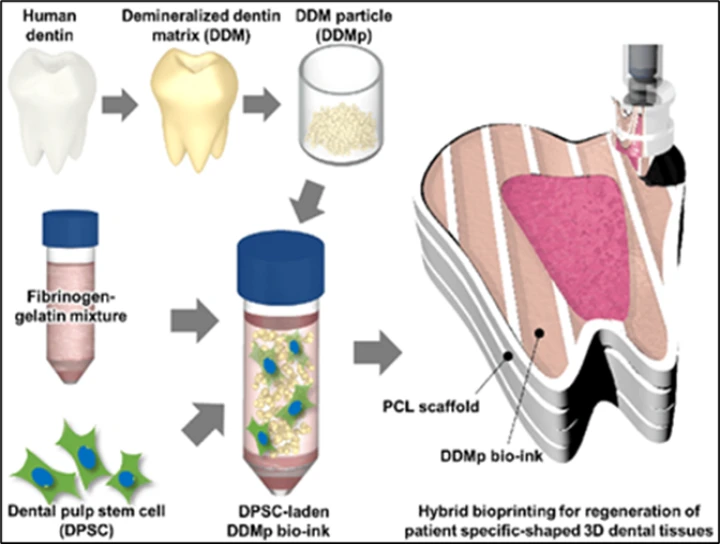
INTRODUCTION
The field of endodontics has come a long way in recent years with the introduction of new technologies and techniques that aim to improve patient outcomes. One of the most exciting developments in endodontics is 3D bioprinting, a process that involves creating three-dimensional structures from biological materials. In the case of endodontics, 3D bioprinting can be used to create pulp and dentin, two important components of a tooth.
The process of 3D bioprinting involves creating a digital model of the required structure. The printer uses a bioink, a substance made from living cells, to create the structure. 3D printing is a method of additive manufacturing technology, it utilizes a layer-by-layer method to deposit bio-inks. It is the coordinated motion of stages in the X, Y, and Z directions, whereas an automated system dispenses synthetic inks via different mechanisms.
There are several advantages to using 3D bioprinting in endodontics. Firstly, it allows for the creation of precise, customized structures that are tailored to each patient's individual needs. This can lead to better outcomes, as the structures are designed to fit perfectly and promote healing. Secondly, 3D bioprinting can create tissue in a laboratory setting, which can then be transplanted into a patient's body. This is known as tissue engineering and can potentially revolutionize the field of endodontics. By creating new, healthy pulp and dentin tissue, it may be possible to repair damaged teeth and reverse the effects of decay and infection.
BIO INK FOR BIOPRINTING DENTAL TISSUE
1. Hydrogel bio-ink
- Alginate hydrogels
- Gel MA
- Dentin-derived hydrogel
2. dECM- based bioink
Regeneration of the dentin pulp complex.
1. Reparative dentin and mineral formation:
Localized growth factors related to dentin formation can be placed between the pulp tissue and the wall of the pulp cavity via 3D bioprinting to induce odontoblast differentiation at specific positions.
2. Pulpal revascularization: Human DPSCs and 5% Gel MA hydrogels with HUVECs, and the human cell‐seeded Gel MA hydrogels promoted the well‐organized neo-vasculature formation.
3. Pulp neurotization:
A 3D micro-periodic scaffold made of poly (2-hydroxyethyl methacrylate; pHEMA) by direct-write assembly of a photopolymerizable hydrogel ink can support the growth of primary rat hippocampal neurons. It allowed the neuronal cells to form differentiated and intricately branched networks. A "lock and key" mold made by 3D printing, which consisted of a cryopolymerized Gel MA cellularized with adipose-derived stem cells (ASCs) was also found to ensure the proliferation and survival of the seeded ASCs and upregulate the messenger RNA expression of their neurotrophic factors in vitro. Moreover, the bio conduit supported the reinnervation across a 10-mm sciatic nerve gap.
CONCLUSION
3D bioprinting can potentially reduce the need for invasive procedures like root canal therapy. By creating new tissue, it may be possible to repair damaged teeth without the need for extensive drilling and filling.
Challenges to be overcome include more research to determine the long-term safety and efficacy of tissue engineering.


No Any Replies to “3D Bioprinting of Pulp and Dentin: Revolutionizing Endodontics”
Leave a Reply